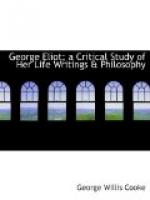But all thy anguish and thy discontent
Was growth of mine, the elemental
strife
Towards feeling manifold with vision blent
To wider thought: I was
no vulgar life
That like the water-mirrored ape,
Not discerns the thing it
sees,
Nor knows its own in others’ shape,
Railing, scorning, at its
ease.
Half man’s truth must hidden lie
If unlit by sorrow’s eye.
I by sorrow wrought in thee
Willing pain of ministry.
The intellectual surroundings of Marian Evans at this time gave shape to her whole after-life. There were now laid the foundations of her mode of thinking, and her philosophic theories began to be formed. It was in the home of one of her friends she learned to think for herself, and it was there her positivist doctrines first appeared. Charles Bray was affected by the transcendental movement, and was an ardent admirer of Newman, Emerson and others among its leaders. This interest prepared him, as it has so many other minds, for the acceptance of those speculative views which were built up on the foundation of science when the transcendental movement began to wane. The transcendental doctrines of unity, the oneness of mind and matter, the evolution of all forms of life and being from the lowest, the universal dominion of law and necessity, and the profound significance of nature in its influence on man, as they were developed by Goethe, Schelling, Carlyle and Emerson, gave direction to a new order of speculation, which had its foundations in modern science.
Bray was an ardent phrenologist, and in 1832 published a work on The Education of the Feelings, based on phrenological principles. In 1841 appeared his main work, The Philosophy of Necessity; this was followed several years later by a somewhat similar work, On Force, its Mental and Moral Correlates. His philosophy was summarized in a volume published in 1871, which was entitled A Manual of Anthropology. He also wrote pamphlets on “Illusion and Delusion,” “The Reign of Law,” “Toleration,” and “Christianity.” In his work on necessity he promulgated very many of those ideas which have formed so prominent a part of the philosophy of George Eliot. The dominion of law, the reign of necessity, experience as the foundation of knowledge, humanity as an organism that develops a larger life for man by the aid of experience and tradition,—these are among the doctrines of the book. There is every reason for believing that in the teachings of Charles Bray, Marian Evans found many of the main elements of her philosophy, and with his aid her opinions were largely shaped.




